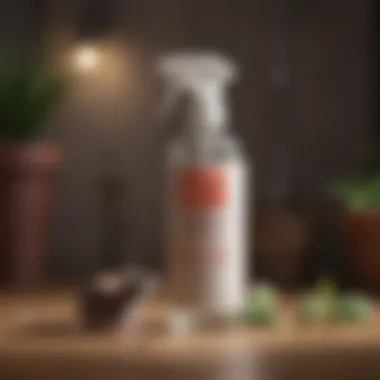Natural Home Remedies to Effectively Repel Mice


Intro
Mice are a common nuisance for many homeowners. Their presence can lead to health risks and damages to property. Instead of reaching for chemical solutions, many people are exploring home remedies for repelling these pests. This article aims to provide an insight into effective natural alternatives to traditional pesticides, focusing on easily accessible ingredients and methods.
In recent years, there has been a significant shift toward eco-friendly solutions. As homeowners become more aware of environmental impacts, the demand for natural repellents is on the rise. Many people are keen to learn about how they can protect their homes without relying on harmful substances. This guide will comprehensively cover various remedies, their preparation, and application techniques.
Common Ingredients for Mice Repellents
Various natural ingredients have proven effective in repelling mice. They are simple to use and often found in household items. Here are some notable examples:
- Peppermint oil: Its strong scent is a known deterrent for rodents.
- Cayenne pepper: This spicy ingredient can irritate a mouse’s sensitive nose, making them steer clear.
- Vinegar: The strong smell of vinegar can disrupt a mouse's sense of smell.
- Ultrasonic devices: These emit a sound that is unpleasant to pests but undetectable by humans.
Combining several of these ingredients can enhance their effectiveness. It is important to remember that consistency in application yields better results.
Preparation Methods
Proper preparation of these ingredients is crucial. Here is how you can create your own mouse-repelling solutions:
Peppermint Oil Spray
- Ingredients: 10-15 drops of peppermint oil, 1 cup water, spray bottle.
- Method: Mix the peppermint oil with water in the spray bottle and shake well. Spray in areas prone to mice activity.
Cayenne Pepper and Water Mixture
- Ingredients: 1 tablespoon cayenne pepper, 1 cup water.
- Method: Combine cayenne pepper with water in a bottle, shake, and spray around entry points.
Vinegar Disinfectant
- Ingredients: 1 part vinegar, 1 part water.
- Method: Mix equal parts vinegar and water in a spray bottle. Use this as a cleaning agent in areas where mice might frequent.
Application Techniques
Effective application expands the reach of these remedies. Regularly refreshing your solutions is essential. Here are some tips for best practices:
- Apply your homemade sprays every few days, ensuring the scent remains potent.
- Focus on entry points like doors, windows, and cracks.
- Use cotton balls dipped in peppermint oil as strategic placements in the kitchen and pantry.
Regular checks of these areas will be beneficial. Additionally, it can be useful to combine repellents with preventive measures. This includes sealing cracks and keeping food in airtight containers.
Closure
Home remedies for mice repellent offer a practical solution for managing unwanted pests. By utilizing common ingredients and following proper preparation and application techniques, homeowners can create effective barriers against mice. This approach aligns well with the growing inclination towards sustainable living. The amalgamation of knowledge and practical skills equips individuals with the confidence to address pest issues naturally, promoting a healthier home environment.
"Natural solutions not only protect your home but also contribute positively to the environment."
Stay tuned for more details on each remedy in following sections.
Understanding Mice Behavior
Understanding the behavior of mice is crucial for homeowners seeking to combat infestations in their living spaces. Mice are small, agile rodents that thrive in various environments, including human residences. This section will explore why mice are enticed to invade homes and how recognizing signs of their presence can assist in prevention efforts.
Reasons Mice Enter Homes
Mice typically enter homes for several reasons. Here are a few key factors that attract them:
- Food Sources: Mice are opportunistic feeders. They are drawn to easily accessible food, including crumbs, leftovers, and pet food. The presence of open garbage or food not stored properly can be an open invitation.
- Shelter from Harsh Conditions: Mice seek warmth and protection from extreme weather. During colder months, they might look for cozy spots that provide insulation from the cold, making attics or basements ideal environments.
- Nest Building Materials: Mice require nesting materials to create safe spaces for reproduction. They often find these materials in human homes, such as paper or upholstery.
Understanding these reasons can help homeowners approach the issue proactively rather than reactively.
Identifying Mouse Infestation


Early detection of a mouse infestation is vital for effective remediation. Here are the common signs to look for:
- Droppings: Mouse droppings are small, dark pellets often found near food sources or nesting areas. Noticing these should raise immediate concern.
- Nests: Mice build nests from soft materials, often hidden in out-of-sight areas like behind appliances or inside cabinets.
- Grease Marks: Mice tend to travel along regular paths. This movement often leaves behind greasy smudges on floors and walls, which can indicate their routes.
- Noises: Sounds of scurrying or squeaking during the quiet hours can be a strong sign of an active infestation.
Recognizing these signs promptly can aid in implementing effective home remedies and strategies that will deter mice from your living spaces.
Common Home Remedies for Mice Repellent
Home remedies for mice repellent are essential for homeowners seeking effective, non-toxic solutions to ward off these persistent pests. Unlike chemical-based repellents, these natural alternatives leverage readily available ingredients to deter mice without introducing hazardous substances into the home environment. Understanding these remedies helps in making informed choices that fit the needs of a household while considering safety and efficacy. Moreover, home remedies can be tailored to individual preferences, providing flexibility in application and use.
Essential Oils
Peppermint Oil
Peppermint oil is often praised for its strong, minty aroma which is unappealing to mice. This oil’s potency makes it a popular choice among homeowners looking for natural repellents. One key characteristic is its ability to mask scents that attract mice. The distinct smell effectively confuses their sense of smell. However, it requires consistent application, as the scent dissipates over time.
Eucalyptus Oil
Eucalyptus oil serves as another potent deterrent against mice. Its fresh scent repels the pests, similar to peppermint oil, acting on their acute sense of smell. The oil contains compounds that thwart their natural behavior, keeping them at bay. However, like peppermint oil, eucalyptus can lose its effectiveness without regular use, which requires ongoing commitment from homeowners.
Clove Oil
Clove oil stands out due to its strong aromatic profile, making it effective as a mice repellent. The presence of eugenol, a crucial component of clove oil, enhances its repellent properties. Homeowners appreciate clove oil for its dual function; not only does it deter mice, but it also has antiseptic properties. However, it may cause allergic reactions in some individuals, so careful consideration is required before use.
Natural Deterrents
Vinegar
Vinegar is a common household item known for its versatile applications. Its strong scent is off-putting to mice, making it a beneficial repellent choice. The primary characteristic of vinegar is its acidity, which contributes to its ability to disrupt the odors that attract mice. While it is effective, the drawback is that its smell, although unpleasant for mice, may also be strong for the inhabitants.
Ammonia
Ammonia's strong scent serves as a warning for mice, prompting them to stay away from treated areas. Its powerful odor mimics the scent of predator urine, making it an effective deterrent. Homeowners find ammonia appealing for its cost-effectiveness, yet it is vital to handle it with care, as it can be toxic if misused, particularly around pets and children.
Cayenne Pepper
Cayenne pepper is valued not just for its flavor but also for its pungent odor that is irritating to mice. When used as a repellent, it can be sprinkled in areas where mice are seen. Its unique feature lies in its capsaicin content, which deters mice due to irritation. However, for those sensitive to spicy foods, handling cayenne can pose difficulties, so caution is advised.
Homemade Repellent Sprays
Recipe Using Essential Oils
Creating homemade repellent sprays using essential oils is an effective way to leverage their natural deterrent properties. A simple recipe may include a mix of peppermint oil and water in a spray bottle. Its benefit lies in customization; homeowners can adjust concentrations based on their preference. However, results may vary, and regular application is necessary for effectiveness.
Vinegar-Based Solution
A vinegar-based solution provides an easy, homemade alternative. Mixing equal parts vinegar and water and spraying in affected areas can help repel mice. This method is appealing because of its simplicity and accessibility. Its disadvantage is the tendency for the smell to fade quickly, requiring frequent reapplications for sustained efficacy.
Preparation and Application of Remedies
The preparation and application of remedies play a pivotal role in successfully repelling mice. Understanding how to effectively create and utilize these natural solutions is essential for homeowners seeking a pest-free environment. Proper preparation ensures that the ingredients maintain their potency and effectiveness. Likewise, the application methods determine how well these remedies disperse in the locations where mice are often present.
When preparing repellent solutions, it is important to consider the ingredients used. Many of these items are easily found around the home, thus making them accessible and cost-effective. Moreover, the way these solutions are applied can either enhance or diminish their effectiveness. Keeping areas clean and targeted allows for better results and reduces the chances of a recurring infestation.
How to Prepare Repellent Solutions
Preparing mouse repellent solutions requires careful selection of ingredients and proper mixing techniques. Being precise in the ratios is crucial. For example, when using essential oils, a typical mixture might involve diluting a small amount in water, ensuring the oil disperses effectively. It's important to mix thoroughly to avoid separation.
Using fresh ingredients enhances the effectiveness of your solutions. Ingredients like vinegar or cayenne pepper can lose their potency over time. Therefore, creating small batches that can be used quickly is recommended. Assessing the type of solution based on where it will be used is vital as well. For example, stronger solutions can be used in more heavily infested areas, while milder solutions work better in spaces such as kitchens and living areas where children or pets may be present.
Effective Application Techniques


Using Cotton Balls
Using cotton balls is a practical method for applying repellent solutions. They are easy to work with and can absorb liquids effectively. Once soaked in a repellent solution, they can be placed strategically around potential entry points. This technique allows for a slow release of the scent, maintaining a deterrent effect over time.
One of the key characteristics of cotton balls is their affordability, as well as how easily they can be replaced when the scent fades. However, a disadvantage is that they can be consumed by pets or children, which necessitates careful placement.
Spray Bottles for Even Distribution
Spray bottles offer a versatile way to apply repellent solutions evenly across surfaces. This method allows for better coverage, which can be vital in areas where mice tend to interact most. By using a spray bottle, homeowners can cover a wider area without needing to create a mess.
The main advantage of using spray bottles is that it enables a controlled application. Moreover, it allows for quick reapplication as needed. However, one must ensure that no ingredients harm the surfaces being treated, thus careful selection of solutions is necessary.
Proper preparation and application enhances the effectiveness of home remedies, creating a more pest-free environment effectively.
Choosing the right technique depends on personal preferences and the specific conditions of the home. Understanding how to prepare and apply these remedies ensures optimal results and can lead to long-term pest management.
Efficacy of Home Remedies
Understanding the efficacy of home remedies is essential when addressing the problem of mice in your home. Home remedies offer a natural alternative to chemical solutions. Their effectiveness can vary based on various factors, such as the type of remedy and the extent of the infestation.
It is important to examine both the short-term and long-term effectiveness of these remedies, as well as any testimonials from users who have tried these methods. This helps homeowners determine the best course of action for managing their mouse problem.
Analyzing the Effectiveness
Short-term vs Long-term Results
Short-term results provide immediate relief from mice presence, which can be crucial when you notice an infestation. Commonly used home remedies, such as peppermint oil or vinegar, can quickly deter mice due to their strong scents. However, long-term results are also important. They offer a sustainable plan for mouse control. Long-term effectiveness can determine whether the remedies you use will continue to repel mice or if you will need to adapt your strategy over time.
Essentially, while short-term results can be quite effective at first, they may not provide a permanent solution. Continued application of these remedies may be necessary to maintain efficacy. Thus, homeowners must evaluate the trade-off between immediate relief and the need for ongoing maintenance to ensure long-term success in keeping mice at bay.
User Testimonials and Case Studies
User testimonials and case studies can shed light on the practicality of home remedies. They offer real-world insights into how individuals have experienced various methods for mouse repellent. Positive testimonials often highlight the ease of preparation and application of these remedies, as well as their ability to create a pest-free environment.
On the other hand, it is essential to consider mixed reviews. Not all experiences will be the same, and some users may find lesser success due to specific conditions in their homes. The uniqueness of individual situations, including the severity of the infestation and environmental factors, can affect outcomes. Thus, while testimonials serve as a useful guide, they should be considered alongside other evidence of efficacy.
Common Limitations
Though many home remedies are effective, some limitations exist that can influence their overall success. Awareness of these limitations is critical for homeowners seeking a long-lasting solution.
Resistance of Mice
Mice may develop resistance to certain scents or substances over time. This means that a treatment that once worked may become less effective. Such resistance influences how quickly and reliably a remedy will deter mice. It is important to rotate various remedies to mitigate this issue. By introducing new methods, you can decrease the chances of mice becoming accustomed to a specific repellent, ultimately preserving the effectiveness of your efforts.
Environmental Factors
Environmental factors play a significant role in the success of home remedies. These can include seasonal changes, humidity, and the overall cleanliness of the environment. For instance, during colder months, mice tend to seek warmth indoors, making them more likely to enter homes regardless of available repellents. Additionally, a poorly maintained living space may create more opportunities for mice to thrive.
Homeowners need to understand these factors as they implement their strategies. This knowledge can enhance the application of home remedies, leading to better results in keeping homes free of mice.
Safety Considerations
When dealing with home remedies to repel mice, the aspect of safety cannot be overlooked. Using various ingredients means that homeowners must be vigilant in ensuring that these solutions do not inadvertently cause harm to themselves, their pets, or the environment. Safety considerations are vital to establish a balance between effectiveness in repelling mice and maintaining a secure living space.
Potential Toxicity of Ingredients
Essential Oil Safety
Essential oils, such as peppermint and eucalyptus, are popular choices for creating natural deterrents. These oils possess certain characteristics that make them effective against mice. For instance, the strong scents can overwhelm rodents, driving them away from treated areas. However, there is a primary concern regarding their toxicity. While many essential oils are safe for humans, not all are safe for pets.


Furthermore, some oils must be diluted before application as they may cause skin irritation or respiratory issues. Therefore, it is essential to follow usage guidelines carefully. Despite these cautions, essential oils remain a beneficial option for homeowners who prefer eco-friendly solutions. Their aroma not only aims to repel pests but can also provide a pleasant scent within the home.
Using Ammonia Safely
Ammonia is another effective mice repellent that has been used for quite some time. Its pungent smell mimics that of predator urine, making it an intimidating presence for mice. However, while ammonia has its advantages, it is crucial to approach its use with caution.
The strong fumes can be irritating to the eyes and lungs, and direct contact with skin may cause discomfort. A lesser-known concern is the potential for ammonia to combine dangerously with certain cleaning products, creating toxic fumes. Therefore, it is essential to use ammonia in well-ventilated areas and to keep it out of reach of children and pets.
Impact on Pets
Homeowners with pets should consider the effects of these remedies on their furry companions. Many essential oils can be toxic to cats and dogs. Even small amounts can lead to serious health issues. Therefore, understanding the toxicity levels of ingredients is crucial when selecting a home remedy for mice.
For those with pets, monitoring the pet's behavior around the treated areas is vital.
Complementary Strategies
Complementary strategies play a critical role in enhancing the effectiveness of home remedies for mice repellent. While remedies such as essential oils and natural deterrents can deter mice, taking additional steps greatly improves the likelihood of keeping these pests at bay. Implementing strategies to seal entry points and maintaining a clean environment are essential measures that homeowners should not overlook. By combining these methods with home remedies, an integrated approach can be developed to create a hostile environment for mice.
Preventing Entry Points
Sealing Cracks and Holes
The process of sealing cracks and holes is fundamental in the fight against mice. Mice are skilled at finding small openings to enter homes, making it important to pay attention to details in construction and maintenance. By meticulously inspecting areas around doors, windows, and the foundation of the house, homeowners can block pathways effectively.
One key characteristic of sealing cracks is its low cost and efficiency. Products like caulk and steel wool can be used to fill these openings. This technique is beneficial because it not only prevents mice from entering but also enhances home insulation. A unique feature of this strategy is its long-lasting impact; once gaps are sealed, the likelihood of future infestations decreases significantly. However, homeowners must continuously monitor for movement or changes in the building structure, as neglect over time can reopen these entry points.
Maintaining Cleanliness
Maintaining cleanliness in the home is another crucial aspect of keeping mice away. A clean home reduces food sources and potential nesting sites for these rodents, making it less attractive for them to invade. Regular cleaning routines can help in this effort, especially in kitchens and dining areas where food debris tends to accumulate.
The key characteristic of this approach lies in its simplicity. Simple tasks like sweeping, vacuuming, and securely storing food can significantly change a home's appeal to mice. The unique advantage of maintaining cleanliness is that it works in conjunction with other deterrent methods, enhancing their effectiveness. On the downside, it requires continual effort and vigilance from homeowners, but the benefits of a cleaner, pest-free environment are well worth it.
Natural Predators
Advantages of Cats
Utilizing natural predators, such as cats, can be an effective method of pest control. Cats are instinctive hunters and are known to control mouse populations both inside and outside the home. By employing a cat as a companion, homeowners not only benefit from its company but also from its ability to deter mice.
The primary key characteristic of having cats is that they are generally low-maintenance in terms of pest control. They tend to patrol areas regularly, making their presence known to potential intruders. One of the advantages of this strategy is its sustainability; a cat’s hunting instincts provide a long-term solution to the issue. However, homeowners must also consider the needs of the pet, such as proper care and attention.
Encouraging Owls
Encouraging owls to inhabit nearby areas can also serve as an effective mouse control method. Owls are natural predators of mice and can significantly reduce their populations without much effort from the homeowner. This strategy is often overlooked, yet it can be quite beneficial.
One of the main characteristics of encouraging owls is that they assist in dealing with pest control in a non-intrusive manner. Homeowners might attract these birds by providing suitable nesting areas and avoiding disturbances in their local habitat. The unique feature of this approach is its ecological nature, supporting a balanced ecosystem. However, attracting owls does require patience and does not offer as immediate a result as other methods.
In summary, implementing complementary strategies enhances the overall effectiveness of home remedies for mice repellent. By sealing entry points, maintaining cleanliness, and utilizing natural predators, homeowners can create a comprehensive pest control plan. This integrated approach gives homeowners a greater chance of reducing their mouse problems efficiently.
Finale and Recommendations
Addressing the issue of mice presence in homes is more than an inconvenience; it can pose health risks and damage property. The conclusion of this article synthesizes core insights and practical strategies that have been discussed. The emphasis on home remedies is rooted in their accessibility and the potential for safer pest management without reliance on harsh chemicals. By leveraging natural ingredients and methods, homeowners can effectively deter mice while minimizing harm to the environment and their households.
In this section, we will summarize the key points covered throughout the article and provide recommendations for further action. A focus on proper application of remedies, combined with understanding mouse behavior, is essential for achieving lasting results. Homeowners should remain vigilant and be proactive in maintenance to deter infestation.
Summary of Key Points
- Understanding Mice Behavior: Recognizing why mice enter homes aids in prevention. Factors such as food availability and shelter are significant drivers of infestation.
- Common Home Remedies for Repellent: Various remedies, including essential oils and natural deterrents like vinegar and ammonia, offer effective means to repel mice. Each method has unique properties that contribute to its efficacy.
- Preparation and Application: Proper preparation and effective application techniques, such as the use of cotton balls or spray solutions, enhance the potential of home remedies.
- Efficacy: While home remedies can yield short-term benefits, understanding their limitations, such as potential resistance from mice and environmental influences, is crucial.
- Safety Considerations: Organic solutions are generally safer, but it is essential to be aware of any toxic properties that certain substances may contain, especially concerning pets and children.
- Complementary Strategies: Employing preventive measures, including sealing entry points and maintaining cleanliness, can significantly reduce the likelihood of infestation.
Further Reading and Resources
Links to Relevant Studies
Research on pest management and home remedies reveals a variety of insights that enhance understanding of rodent control. Studies often highlight the effectiveness of specific natural solutions over time. One notable study is found at en.wikipedia.org, focusing on rodent behavior and control strategies. This research emphasizes practical applications and scientifically backed solutions, making it a valuable resource for homeowners.
Books on Pest Management
For those wanting to delve deeper into pest control literature, many books provide extensive knowledge on various strategies. "Pest Control Strategies" stands out due to its comprehensible approach and detailed examination of both natural and chemical methods. This book is beneficial because it equips readers with knowledge about modern pest control, offering unique views on the effectiveness and risks of different methods. Readers might also find drawbacks, such as the complexity of some preventive measures discussed in these resources, which may overwhelm novice homeowners.



